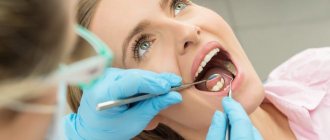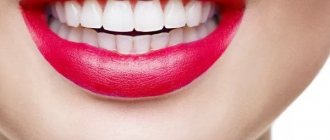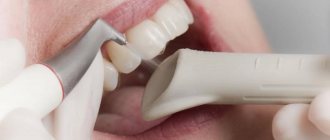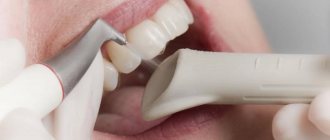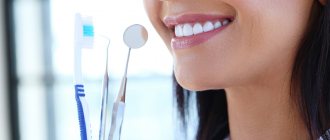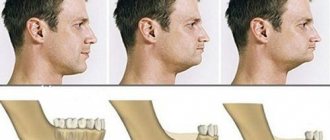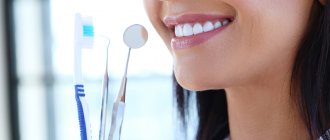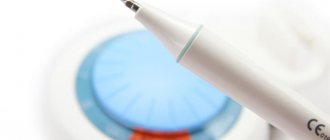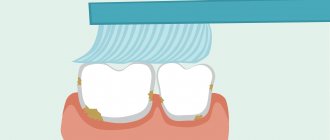Professional hygienic cleaning of teeth and oral cavity at the dentist - what is it, how is such a procedure carried out? Doctors recommend using this method once every six months. During one visit to the dental office, a whole range of measures is carried out: plaque and hard deposits (stone) are removed, inflammatory diseases are prevented, and the general condition of the dentition is improved.
Currently, there are several methods of cleansing, which include laser, ultrasound, and the modern “Air Flow” technique. Carrying out a hygienic procedure in dentistry has many advantages and is popular among patients.
Differences between professional teeth cleaning and daily cleaning
In addition to daily morning and evening sessions with a brush and paste, other manipulations should be performed to help maintain the health of the mucous membranes and prevent the formation of plaque and tartar. Dentists advise periodically seeking professional help, because usual care at home does not provide one hundred percent protection against deposits.
Hard-to-reach places (interdental spaces, the inside of the chewing units on both jaws) are difficult to clean. As a result, an environment favorable for pathogenic microorganisms is formed in hidden areas, and pathogenic bacteria begin to actively multiply.
The process of mineralization of the soft bacterial layer is not noticeable to the naked eye. Because of this, the patient may not even realize for several months that he has tartar.
If you do not consult a doctor promptly, hardened deposits can cause serious complications. Caries, periodontitis, gingivitis and other pathological processes develop.
How do you know if you need to have your teeth cleaned at the dentist? Is it worth spending time and money visiting the clinic? Cases when this is necessary:
- subgingival or supragingival stone has formed;
- food particles have accumulated on surfaces and formed a dense whitish layer;
- the mouth smells unpleasant;
- gums bleed, pain is present;
- for preventive purposes to prevent periodontal disease and gingivitis.
Portable irrigators for travel –
If you want to save space in the bathroom or be able to take a irrigator with you on a trip, portable models of irrigators are suitable for you, but keep in mind that high-quality portable models are much more expensive than stationary ones. Cheap portable irrigators most often have 1) the water jet pressure does not correspond to the declared one, 2) poor tightness, 3) low service life and non-repairability, 4) lack of microbubble technology.
Another feature that you should pay special attention to is that their water tank is only 140 to 200 ml (for stationary ones, most often 600 ml). This means that you will have to refill the water tank many times during one procedure. You can see how this is done in the photo below. We definitely recognize the Panasonic EW1511 and EW1411 irrigators as the best portable devices.
Portable models of irrigators –
1) Panasonic irrigators –
These irrigators have the richest functionality, microbubble technology (ultrasonic cleaning), as well as a high degree of reliability. The most advanced model is the Panasonic EW1511 irrigator. Main characteristics: water jet pressure from 195 to 647 kPa (5 adjustable power levels), jet pulsation 1600 per minute, 200 ml reservoir - enough for 60 seconds of continuous use (in the highest water pressure mode), 2 nozzles included, 2 guarantee of the year. Cost from 9000 rubles.
Irrigator Panasonic EW1411 – maximum water pressure 590 kPa, 1400 water pulses per minute. The most basic difference between this irrigator is the presence of 4 operating modes - 1) pulse mode with a jet pressure of 590 kPa, 2) continuous jet mode without pulses with a pressure of 590 kPa, 3) “normal” air mode - with a pressure of 390 kPa, pulsed water supply and air microbubbles, 4) soft air mode - with a pressure of 200 kPa, pulsed water supply and air microbubbles. Cost from 8000 rubles.
2) Irrigators Oral-B Aquacare Pro-Expert 4/6 –
Above, we spoke quite highly of the Oral-B stationary irrigator - the Oral-b OxyJet model, and indeed it is an excellent oral irrigator. Portable irrigators of this or “Oral-B Aquacare Pro-Expert 6” are also available with microbubble technology and pulsed water supply (1400 pulses per minute). But we cannot recommend them for purchase, and the point here is the rather low water pressure! Moreover, the water pressure becomes higher if you use this irrigator with the lid slightly open to fill the water tank, which is really not very convenient.
Of course, this indicates an engineering error (when the pump operates, something close to a “vacuum” is created in the water tank), and therefore the pump pumps water slowly. Those. In order for the water pump to pump at a level of 500-600 kPa, there must be a small technical hole in the upper part of the tank to draw in a volume of air equal to the volume of water used. In general, all this indicates an engineering mistake by the manufacturer. And you’d better turn your attention to portable irrigators from other companies, or purchase its stationary version.
3) Irrigator “CS Medica AquaPulsar CS-3 Air+”
Another device with microbubble technology is the CS Medica AquaPulsar CS-3 Air+ portable irrigator. Characteristics: maximum jet pressure 590 kPa, pulse frequency 2000 per minute, tank volume 130 ml. The set includes 4 attachments, including standard, periodontal, for braces and for sensitive gums. In principle, this is a very interesting irrigator at a price of about 3,500 rubles, and in its functionality (operating modes) it is somewhat reminiscent of Panasonic.
So, this irrigator has 3 operating modes: 1) Intensive mode - with a jet pressure of 590 kPa, pulsed water supply, without microbubbles, 2) NORMAL Air mode - with a jet pressure of 390 kPa, pulsed water supply and air microbubbles, 3) SOFT mode Air – with a pressure of 200 kPa, pulsed water supply and air microbubbles.
Conclusions: In general, the choice of portable irrigators with ultrasonic (microbubble) technology is limited to just a few manufacturers. Most other manufacturers produce portable irrigators with only regular pulse water supply, which is certainly not optimal. It’s better not to buy portable devices that are cheap in terms of functionality, such as the Xiaomi Soocas W3 irrigator, although on the other hand, even such models are still better than nothing at all.
Cleaning methods at the dentist
Professional hygienists and periodontists use a whole arsenal of methods for cleaning teeth. This can be the simplest influence (instrumental) or more advanced (Air Flo, ultrasonic, etc.). Which option to choose depends on the following factors:
- the patient’s health status, his well-being;
- thickness, structure, density of plaque or stone;
- age (some activities are contraindicated for children);
- location of formations;
- financial opportunities.
It is also possible to use several techniques for complex effects. In this way, you can speed up the onset of a positive result and prolong the effect for up to six months or more.
Mechanical (manual)
One of the oldest methods, which does not lose popularity due to its affordable price. The use of expensive equipment is not required here; the doctor uses special tools with hooks to remove hard deposits.
The procedure has a significant drawback. As a result of mechanical impact, the enamel may be damaged. It cannot be performed if a person has hypersensitivity. In some situations, this option is the only acceptable option if there are contraindications.
Using the Air Flow system
What is included in professional teeth cleaning with Air Flo: the teeth are treated with a mixture of water, abrasive particles and air. All this is supplied under a certain pressure. The layer is easily removed without causing any discomfort to the patient, and the structure of the units is not affected. The enamel becomes several shades lighter. Unfortunately, such a delicate method cannot get rid of old deposits.
Ultrasonic
Ultrasound crushes the hardened layers, and their particles are then washed out with water. This way you can remove plaque and stone not only from visible surfaces, but also from hard-to-reach places (for example, in the spaces between teeth). If the accumulated layer was too hard and old, discomfort may be present for several days.
Laser
The laser beam removes old deposits. The person does not experience pain or other discomfort; the incisors, canines and molars remain intact. The condition of soft tissues improves. In addition, the method helps disinfect the oral cavity. The procedure will cost more than other types of cleansing.
Polishing
In this way, the dentist eliminates unevenness and microcracks on surfaces that formed after applying the above methods. If you skip this step, the enamel will be rough and food particles will be trapped on it. As a result, plaque will very quickly accumulate again, harden and turn into stone.
How is hygienic teeth cleaning done, are special tools needed? Hard fabrics are polished using special devices alternating different types of attachments, such as:
- needle-shaped (for grinding);
- brushes (clean out leftover food);
- polishers (process crowns and dentures);
- discs (give perfect smoothness and shine);
- strips (for interdental spaces).
Fluoridation
This is an optional procedure, but it is still worth agreeing to it. It helps overcome sensitivity, strengthen enamel, and prevent the appearance of carious lesions. Surfaces are treated with special substances – fluorides.
Pros:
- the level of fluoride in the body is normalized;
- the strength of dental units increases;
- the leaching of calcium, which affects vital processes in the skeletal system, is stopped;
- the growth and reproduction of pathogenic microorganisms slows down.
What does the doctor do:
- drying is performed with a jet of air;
- a solution enriched with active ingredients is applied with a brush or using trays;
- recommendations for prevention are given.
Fluoridation is the final stage of purification in a clinical setting.
Irrigator Donfeel (Donfil) –
The Russian company Donfeel produces a wide range of irrigators, and we note that they are of fairly high quality, reasonable price and good functionality. The flagship model, the Donfeel OR-800 irrigator, generates a stream of water with pulsations from 1250 to 1700 per minute, and the water pressure is adjustable from 0 to 680 kPa. This device is also distinguished by the presence of 2 operating modes (standard + gum massage), 10 levels of water pressure adjustment, and the kit includes 5 nozzles.
Moreover, this device can also be used to rinse the nose (together with a special nasal tray and a weak saline solution). The warranty is 1 year, and the cost is only about 3800 rubles. This device has only 1 minus - the lack of microbubble technology. But this technology is implemented in another model - the Donfeel OR-840 AIR irrigator. This is an inexpensive and good irrigator at a price of about 3,400 rubles, and what distinguishes it from the flagship model is that it has only 1 standard operating mode, as well as only 5 levels of water pressure adjustment.
Donfeel irrigator models –
Sets of attachments for Donfeel irrigators –
To summarize, Donfil irrigators have been produced for more than 13 years, and during this time they have shown their reliability. In addition, the manufacturer has a wide network of service centers throughout Russia, and provides service even after the warranty period has expired. It is also necessary to say about the wide range of attachments, among which there are standard, periodontal, for cleaning braces, for cleaning the tongue, for implants, as well as special nasal attachments (for rinsing the nose for sinusitis and rhinitis).
Caring for your teeth after professional cleaning
Based on the results of the procedure, the doctor should give recommendations on proper hygiene. Basic Rules:
- For several days after medical procedures, it is important to clean the teeth not only twice a day, morning and evening, but also after each meal. If this is not possible, it is enough to rinse your mouth with clean water or a special mouthwash.
- The paste and brush should be carefully selected depending on the patient's needs. If in doubt, consult your dentist.
- You need to stop eating hot and cold for a while. This is due to increased sensitivity after external exposure.
- You must completely abstain from smoking for at least 3 days. This way the natural whiteness of the enamel will remain for a long time.
- It is advisable to exclude coloring foods and drinks (tea, coffee, chocolate) from the menu.
- You can’t eat too sour and sugary foods, or chew nuts or candy.
- If the process has been completed with fluoridation, a minimum of two hours of abstinence from food and refusal of standard evening brushing and toothpaste are indicated.
Despite the fairly broad list of recommendations, patients should understand that any medical procedures will be effective when carried out on a regular basis. All pathological processes developing in the oral cavity are easier to prevent than to treat later. For this reason, you should not neglect the advice of professionals and be lazy in caring for your incisors, canines, molars and mucous membranes in your mouth.
How to determine whether you need to have your teeth professionally cleaned by a dentist, and why you should go to him
This is very easy to do - just look into your mouth and assess the condition of your teeth. If the enamel has acquired a yellowish tint, there are brown or grayish spots on it, the gums are swollen and bleeding, they hurt, or there is an unpleasant odor, then you should definitely look into the dental office.
At the same time, do not wait for the symptoms listed above to appear. If pathological processes are started, cleansing will not help. It is for this reason that it is important to have incisors, canines, molars and soft tissues cleaned by a hygienist as a preventive measure.
How often should you have professional teeth cleaning?
There is no clear answer to this question. If the procedure is necessary for preventive purposes to prevent carious lesions, increase the service life of installed filling material, dentures and other elements, then a visit to the clinic once every six months will be sufficient.
Sometimes they resort to cleansing more often, it all depends on the specifics of the case. Smokers, people who drink alcohol, and those who have problems with the digestive organs or bite are included in a separate category. Under such conditions, plaque and stone form much faster.
If prosthetics were performed, teeth should be cleaned at the dentist every 3-4 months. The same goes for people with periodontitis affecting the subgingival pockets. The procedure is performed by a periodontist, as it requires special knowledge and special instruments.
It is important to pre-treat caries and other oral diseases. Only after this will it be possible to evaluate in practice what professional teeth cleaning in dentistry provides.
How much does it hurt
Normally there should be no pain. However, some patients claim that when removing deposits they felt unpleasant and even painful. Some discomfort may be present, this is due to pathological processes such as inflammation of the gums and exposure of the cervical and root parts.
Pain is also possible when the hygienist gets rid of stone in the area of periodontal pockets. If the mineralized layer is too thick, this is also possible. The clinic uses anesthetics that will reduce unpleasant symptoms.
How to eat healthy
To improve the condition of the bone tissue of the teeth, you need to correctly formulate your diet, which should contain foods with a high calcium content. These are fermented milk products, cheeses, red fish, almonds and dark garden herbs (parsley, cilantro, dill).
Foods rich in vitamin C help maintain healthy gums, which strengthens the walls of blood vessels, which means it improves blood supply to the gums, delivering all the beneficial substances to them.
The benefits and harms of the procedure
Having understood the theory of professional teeth cleaning (what it is, what types there are, how the dentist does this procedure), the patient is naturally interested in the advantages and disadvantages. There are many more advantages, these include:
- aesthetically attractive appearance of rows after hygienic manipulations;
- elimination of unpleasant odor from the oral cavity due to getting rid of colonies of pathogenic microorganisms;
- an integrated approach (not only removes accumulated plaque, but also prevents the development of serious dental diseases);
- absence of pain (except when discomfort is associated with pathological conditions and other factors listed in the previous subsection).
Unfortunately, there are also negative sides:
- gum sensitivity increases;
- the risk of injury to the enamel layer increases;
- infection is possible, so some patients are prescribed antibacterial drugs after visiting a hygienist.
Indications
The technique is used as part of the complex treatment of gingivitis, mild and moderate stage periodontitis, and as the initial stage of severe periodontitis.
Characteristic signs of gum disease that require periodontal pocket cleaning:
- dental deposits under the gums that cannot be removed by brushing
- bleeding during hygiene procedures and eating
- swelling of the mucous membrane at the junction with the teeth
- redness, bluish tint
- sensitivity, itching, soreness
- separation of gums from teeth
- bad breath
- exposure of the necks of the teeth
- resorption of bone around teeth
- loose teeth
Contraindications
Despite the effectiveness of the procedure, as well as the harmlessness and safety of professional teeth cleaning in dentistry, in some cases, cleansing methods are contraindicated. This is relevant when:
- diagnosing acute infectious diseases of bacterial or viral etiology;
- inflammation of the mucous membranes of the oral cavity;
- minors (under 18 years of age).
There are also individual limitations specific to individual patients. For example, this may include increased sensitivity of incisors, canines and molars, allergic reactions to anesthetic components and other substances. In any case, you will need a mandatory consultation with a dentist; he will consider all the advantages and compare them with possible risks.
Are there any restrictions for pregnant women
During pregnancy, you need to take care of your health, since the mother is responsible not only for her own body, but also for the condition of the child in the womb. The oral cavity should be given special attention. During the gestational period, many types of professional teeth cleaning in dentistry are allowed (as done using ultrasound and other methods, discussed above), but it is important to take into account some points.
The gestation period is of great importance. In the third trimester, the procedure is contraindicated, since due to stress it can cause intense uterine contractions and lead to premature birth. Until the 28th week of gestation, you can have your teeth cleaned by a hygienist if the expectant mother feels well and the gynecologist at the antenatal clinic has not found any contraindications.
When you come to the clinic, you should notify the doctor about your pregnancy. This way you can choose the safest and most effective method of cleansing.
Are there any restrictions for children and teenagers
Some parents believe that baby's milk units do not require careful care and treatment, since they will fall out anyway and be replaced by permanent ones. If oral hygiene is neglected, premature extraction may be required, which will negatively affect the subsequent eruption of molars, canines and molars.
A child should not be taken to ultrasound and laser, since such methods can harm the fragile and thin children's enamel. How the procedure is carried out, professional teeth cleaning is done for small patients:
- a special paste is applied to strengthen hard tissues and prevent caries;
- “Air-Flow” delicate cleansing is performed (over 6 years of age);
- manual processing (the dentist must have extensive experience and a high qualification category).
Types of curettage
The procedure is carried out in two ways - closed and open. The method is chosen by our periodontist based on studies of the depth of periodontal pockets.
Closed
It is used at the initial stage of periodontitis -
with a depth of gum pockets from 3 to 5 mm , if the inflammatory process has not spread to the bone tissue.
Cleaning resembles comprehensive hygiene, but deeper, and is performed using special curettes. After the deposits are removed, the gum pockets are treated with anti-inflammatory drugs, and the surface of the teeth is polished.
The procedure is effective and low-traumatic. Gum restoration occurs in 3-4 days. However, it requires great skill from the doctor, since it is performed almost blindly with limited access to the dental roots.
In some cases, in the initial stages of periodontitis, cleaning with the Vector ultrasonic device can be used as an alternative method to closed curettage. Produces powerful waves along the surface of the tooth root that destroy dental plaque. However, the decision on the relevance of using the device is made by our periodontist, taking into account the clinical picture.
Open
Used when the depth of the gum pockets is from 5 mm , when the infection has spread along the entire length of the tooth root, and the bone tissue has partially resolved. This is typical for the moderate and severe stages of periodontitis.
The procedure is surgical and involves removing a gum flap to access the roots. Deposits are removed, tooth roots are polished, and antiseptic treatment is performed. When resolving bone structures, the operation is combined with bone tissue augmentation, then a protective membrane is fixed, the flap is returned to its place and sutures are applied.
Compared to the closed method, the open method is more traumatic and requires subsequent rehabilitation of 2-3 weeks. At the same time, the effectiveness of the procedure is very high due to the possibility of visual control of actions. The risk of relapse of inflammation is excluded.
Professional cleaning and braces
If a corrective system is installed to correct the bite, you will have to visit the dentist every 3-4 months. In this case, it can be difficult to achieve high-quality hygiene at home, so professionals come to the rescue.
If hygiene procedures are neglected, caries may develop over time. To do this, you will need to dismantle the structure, which will lead to significant financial costs. In addition, the result of partially completed treatment will be useless.
Having figured out why professional teeth cleaning at the dentist is needed and how the procedure works for certain categories of patients, we can conclude that it is important to carry it out for preventive purposes every six months. If you do not resort to this method of cleansing, you cannot avoid carious lesions, pulpitis and other pathological processes. Accumulated plaque is a favorable environment for the growth and reproduction of pathogenic bacteria, so it is important to get rid of it in a timely manner.
A few more models outside the rating -
Below we will present several more models of irrigators that you can find in online stores. They are generally good too, some even have a 2-year warranty, but they do not have modern micro-bubble technology, which significantly increases the cleaning power of a regular pulsating stream of water.
a) Irrigator B.Well wi-922 / wi-933 –
You can also see B.Well irrigators on sale. Among the stationary models of this company are 1) the B.Well wi-922 irrigator, as well as the B.Well wi-933 irrigator. The water jet of these models has a pulsation from 1250 to 1800 per minute, the pressure of the water jet is adjustable from 207 to 862 kPa. Their cost is 3500 and 4700 rubles, respectively. They differ in that the second model can work not only from the network, but also from the built-in battery, and it is also distinguished by an 800 ml water tank (all other irrigators have a 600 ml tank). Another couple of advantages are a 2-year warranty and a wide range of attachments. They don't have microbubble technology.
Irrigators B.Well wi-922/ wi-933 –
b) Irrigator Revyline RL-100 –
The Revyline RL 100 irrigator has similar characteristics to the B.Well WI-922 irrigator. The pulsation frequency of the water jet is from 1200 to 1700 per minute, and the level of liquid pressure can be adjusted from 210 to 870 kPa (10 operating modes). 2-year warranty, and a wide range of attachments, including standard, periodontal, for cleaning implants, bridges and braces, as well as tongue cleaning. There is no microbubble technology.
Irrigator Revyline RL-100 –
c) Irrigator Aquajet LD-A8 (Aquajet) –
Another option is the Aquajet irrigator - model Aquajet LD-A8. The pulsation frequency of the water jet is 1200 per minute; it can be noted that the range of liquid pressure levels is not very good - from 290 to 810 kPa. Three options for nozzles, one of which has a thin flexible tip (this can be convenient for safely rinsing periodontal pockets). It should be noted that the device is quite bulky. There is no microbubble technology. Cost from 3500 rubles, warranty – 1 year.
The first stage is ultrasonic treatment
Ultrasound of a certain frequency is capable of coloring tartar into small fragments. Therefore, it is used to remove mineralized deposits on the enamel layer in the supragingival and subgingival zone. This procedure is the first item on a comprehensive list. An ultrasonic scaler destroys stone and, along with it, removes pathogenic microflora in the most inaccessible places of the dentition. Ultrasound is absolutely safe for human health in general and gums in particular. The scaler has an attachment that focuses ultrasound radiation on the area that needs to be treated. The device allows manual adjustment of the intensity of exposure. It is determined by the dentist depending on the conditions of a particular clinical case.
Important: a bonus of using ultrasound is its ability to destroy pathogenic bacteria, i.e., to disinfect the surface being treated. Therefore, dentists strongly recommend performing this procedure for patients with periodontal health problems, not only during a course of treatment, but also regularly to prevent inflammation.
